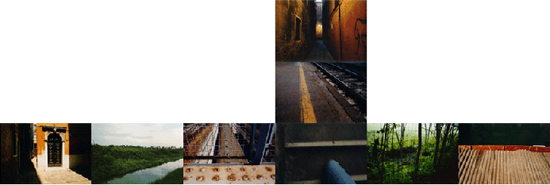
Rebus, 2003, Mounted C-prints on aluminum.
In Venice, Italy, there’s a story that recounts the activities of a brilliant cartographer, Fra Mauro, who lived in the mid-fifteenth century, and created maps of exceptional detail of places previously uncharted (his most famous is presently housed at the Biblioteca Marciana in San Marco square). A great mystery surrounds his work due to the fact that he never left Venice—his abilities seemed to defy normal cartographic practice. Some people suggested that he was merely a collector of information brought to him by other venetian travellers, but this was never substantiated. The story goes that he was a great interpreter of dreams—of the devil. On cloudy and stormy nights, the devil lost control of his dreams and they were projected onto the clouds above Venice, specifically above San Michele di isola, the cemetery. From these projections, Fra Mauro was able to see all the corners of the world without ever leaving the lagoon.
Maps and photographs have something in common—they both have a double life: they exist to represent things depicted in them as well as existing independently of that which they represent. Seeing is, in many ways a discovery of the relationship between the visual and the verbal; the immediacy of looking, and the more delayed, gradual awareness of something that slips through unconsciousness to consciousness; the existence of something, say, a street, it’s concept, something that comprises infinite particulars, that when seen apart from the whole, change the nature of that street. You can get lost in infinite regressions in the same way you can get lost in the labyrinth of Venice.
Rebus is a project that explores the relationship of physical navigation with linguistic processing. I spent last summer photographing the city, the lagoon, and some of it’s hundred-odd islands that comprise it, and made pictures that ultimately formed a kind of typography based on four major motifs: corridors, walls, open spaces, and abstract objects. Then, I placed these images into assemblages that approximated the shapes of some of the multifarious streets that make up the area. Some of the street names include: Calle (lane), corte (deadend), ramo (branch), fondamenta (street paralleling water), and campo (square). Each of these street-types has a particular shape into which my assemblages have been shaped. The streets were interesting to me because of their symbolic latitude; they provide passage or impasse, denote a coming or going, allow for strolling or escape. Procession in a street is much like discourse in a language, it outlines parameters, lets you know what’s acceptable and what’s not. Of particular interest to me is the visual and contextual identity of each photograph and its relation to the whole—to the object to which it is a part. Also, of course, the parallel processes of physical and mental activity, the way you can sometimes see reflections of one in the other, a kind of dream that can be projected onto something physical, a cloud or a wall.


